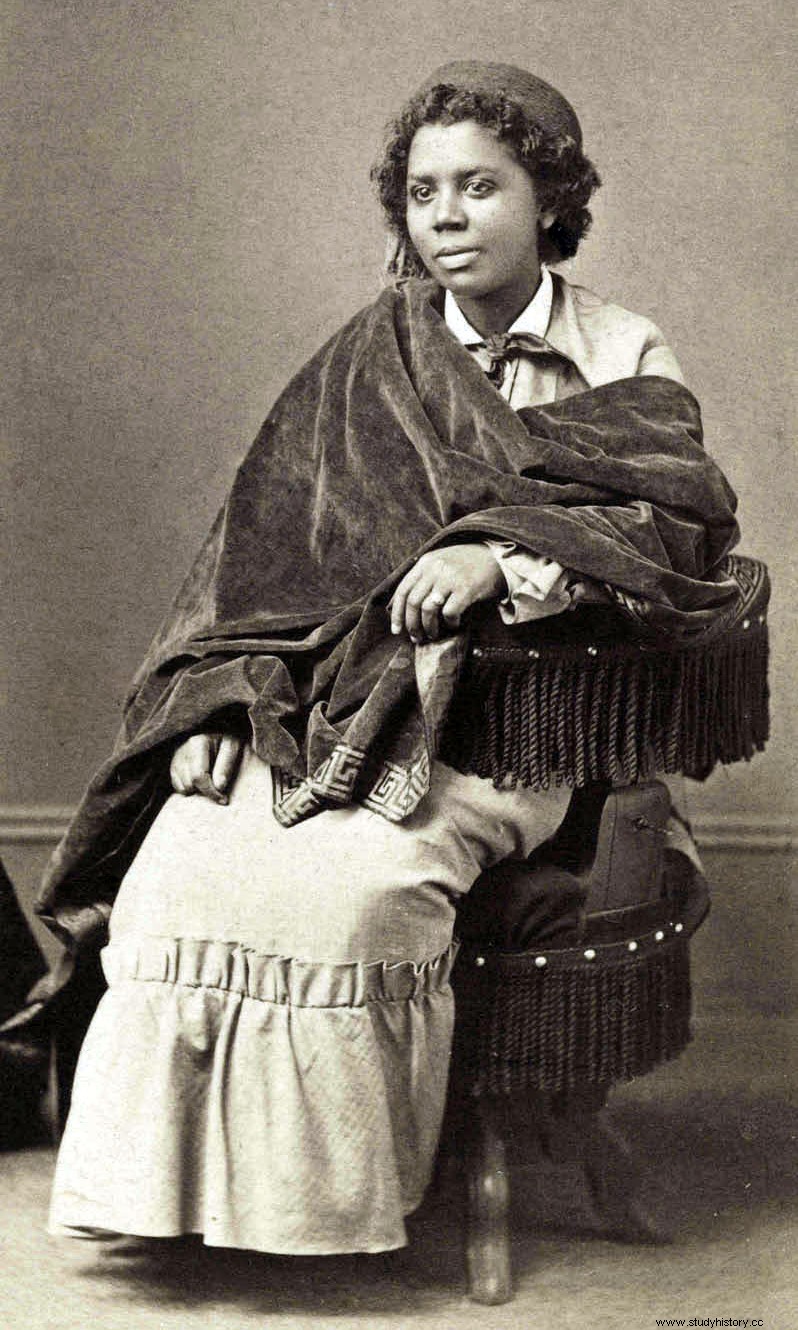American sculptor, Mary Edmonia Lewis (1844 – 1907) draws inspiration for her art from her Afro-American and Native American roots. In the time in which she lives, she is the only black woman recognized for her artistic talents in the United States.
"Wild"
Edmonia Lewis was born on July 4, 1844 or 1845 in Rensselaer, New York, in the northeastern United States. His mother, Catherine Mike Lewis, a talented seamstress, is of Ojibwa descent, a native people of the United States, and African-American; her father, a servant, is Afro-Haitian. Both die when Edmonia is an infant, and the girl is adopted and raised – along with her half-brother Samuel, son of her father – by two maternal aunts. With them, called by her Native American name Wild Fire , the child grows up in contact with the Ojibwe culture.

About ten years older than his half-sister, Samuel left his aunts' home near Niagara Falls to settle in San Francisco. Despite everything, he watches over her from afar, in particular by ensuring her education and paying for her studies. In 1856, Edmonia joined New York Central College, a Baptist school marked by anti-slavery and abolitionist views. She left the establishment after three years, considered “wild”; she said:“Until I was twelve years old I led this wandering life, fishing and swimming … and making moccasins. I was then sent to school for three years in [McGrawville], but was declared to be wild,—they could do nothing with me. » (Until I was twelve, I led a life of wandering, fishing, swimming… and making moccasins. Then I was sent to school in [McGrawville] for three years, but I 'was declared savage - they couldn't do anything with me.)
Oberlin College
After this first experience, Samuel sends his fifteen-year-old sister to Oberlin College in Ohio, an institution also known for its abolitionist positions where she studies art. Oberlin College is the first university to admit African-Americans and girls among its students; that does not prevent the teenager, who renamed herself Mary Edmonia Lewis, from suffering racism, sexism and discrimination on a daily basis. Among the institution's thousand students, there are only about thirty African-American students.
In 1862, while Edmonia was spending three years at Oberlin College, two of her classmates fell ill after drinking a drink she had prepared for them. Although no trace of poison was found, doctors concluded that it was cantharidin poisoning. Rumors accuse Edmonia. One night, as she returns home, she is attacked, violently beaten and left for dead. After the assault, local authorities arrest him and charge him with poisoning. John Mercer Langston, the only African-American lawyer in Oberlin, defends her at her trial, from which she emerges acquitted by the jury. Nevertheless, she finds herself completely isolated at the university. The following year, Edmonia was accused of stealing art materials from the establishment. Acquitted again, for lack of evidence, she does not have the right to re-enroll at university and cannot obtain her final diploma.
Artist debut
Edmonia Lewis moved to Boston in 1864 to start a career as a sculptor. Without a diploma, she benefited from connections within the abolitionist milieu, notably William Lloyd Garrison who introduced her to local artists. This is how she met the sculptor Edward Brackett, who specialized in marble busts and in particular in the portraits of abolitionist personalities, with whom she studied. However, the student and the master ended up separating on bad terms and Edmonia opened his own workshop in 1864.
The young sculptor in turn dedicated herself to creating busts of famous abolitionists of her time, and of heroes of the Civil War which was ending. His bust of Robert Gould Shaw, an abolitionist who had died the previous year during the conflict, impressed the Shaw family, who bought it from him. The sale of a plaster copy of the hero's bust then allows him to put some money aside to pursue studies in Europe. Edmonia also enjoys the attentive ear of the abolitionist press, which regularly covers his art. The young artist is also inspired by the work of the poet Henry Wadsworth Longfellow, notably the poem The Song of Hiawatha inspired by Ojibwe legends.

Rome
In 1865, after having traveled a little in Europe – in London, Paris, Florence – Edmonia Lewis moved to Rome to continue her studies in sculpture. Benefiting from the support of several figures from the artistic and abolitionist milieus, she created relationships within a network of expatriate artists and sculptors.
In Rome, Edmonia encountered less pronounced racism than in the United States, which had just abolished slavery and for which a long period of racial segregation was beginning; she spent most of her career there. Adopting a neo-classical style, she devotes herself to themes and symbols related to her African-American and Native American roots. Thus, his work Forever Free (free forever) depicts a man and a woman whose slave chains are broken; The Arrow Maker (the arrow maker) shows a Native American father passing on his art to his daughter.
Edmonia's talent is recognized in Italy and beyond its borders, to the United States. Her works sell for exorbitant prices, and she organizes several exhibitions of her work, in America and in Europe. In 1876, she participated in the Universal Exhibition in Philadelphia with a monumental work, The Death of Cleopatra (the death of Cleopatra). The work fascinates and attracts thousands of visitors.

End of career
In 1877, Edmonia Lewis commissioned a portrait of former US President Ulysses S. Grant, who approved of the work. In the 1880s, as the neo-classical style gradually lost popularity, the sculptor also saw her notoriety gradually decline. She does not stop sculpting, but devotes herself more and more to pieces dedicated to patrons of the Catholic Church; she herself is very religious.
In 1901, Edmonia moved to London. She died there of illness in September 1907, at the age of 63, after having been largely forgotten.
